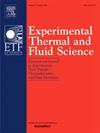Measurement of surface tension and contact angle of solar salt at high temperature with axisymmetric drop-shape analysis
IF 2.8
2区 工程技术
Q2 ENGINEERING, MECHANICAL
Experimental Thermal and Fluid Science
Pub Date : 2024-12-03
DOI:10.1016/j.expthermflusci.2024.111383
引用次数: 0
Abstract
As interfacial properties of common materials enabled many practical applications, those for molten salts would do the same. While their properties are important for the safety and design of thermal energy storage and modular nuclear reactors, they are hard to obtain because of the measurements done in confined spaces inside a furnace at high temperatures. Moreover, a small amount is preferred due to the high cost of salts. To overcome these limitations, an accurate method to measure surface tension, γ, and contact angles, θ, of molten salts were sought. As a steppingstone toward using more complex salts, solar salt was used because of safety and availability. Because molten salts typically show low θ, they provide large errors by incorrectly predicting volume and/or geometry. Therefore, various solid materials on which solar salts show high θ were sought and boron nitride was identified to provide θ > 60°. Later, solar salt sessile droplets were analyzed with the axisymmetric drop-shape analysis (ADSA) method to measure γ over a temperature range, which showed a good agreement with literature. Thus, this paper sets an experimental protocol that can be possibly used for other complex and hazardous salts that are scarcer and hard to handle. This paper extends the current knowledge by identifying solid surfaces on which the salts show low wettability for accurate measurements. Compared to other accurate methods, such as maximum bubble pressure method, this method used a small amount of salt (< 100 μL) while keeping a high accuracy.
用轴对称滴形分析法测定太阳盐的高温表面张力和接触角
由于普通材料的界面特性使许多实际应用成为可能,熔盐的界面特性也会如此。虽然它们的性质对热能储存和模块化核反应堆的安全性和设计很重要,但由于在高温下的炉内密闭空间中进行测量,很难获得它们。此外,由于盐的成本高,最好少量使用。为了克服这些限制,人们寻求一种精确的方法来测量熔盐的表面张力γ和接触角θ。由于安全性和可获得性,太阳能盐被用作使用更复杂盐的垫脚石。因为熔盐通常表现出低θ,它们通过错误地预测体积和/或几何形状而提供了很大的误差。因此,寻找了各种太阳盐表现出高θ的固体材料,并确定了氮化硼提供θ >;60°。随后,用轴对称液滴形状分析(ADSA)方法对太阳盐无根液滴进行分析,在一定温度范围内测量γ,结果与文献一致。因此,本文设定了一种实验方案,可能用于其他较为稀缺且难以处理的复杂危险盐。本文通过确定固体表面上的盐显示低润湿性的精确测量扩展了目前的知识。与其他精确的方法(如最大气泡压力法)相比,该方法使用少量盐(<;100 μL),同时保持高精度。
本文章由计算机程序翻译,如有差异,请以英文原文为准。
求助全文
约1分钟内获得全文
求助全文
来源期刊

Experimental Thermal and Fluid Science
工程技术-工程:机械
CiteScore
6.70
自引率
3.10%
发文量
159
审稿时长
34 days
期刊介绍:
Experimental Thermal and Fluid Science provides a forum for research emphasizing experimental work that enhances fundamental understanding of heat transfer, thermodynamics, and fluid mechanics. In addition to the principal areas of research, the journal covers research results in related fields, including combined heat and mass transfer, flows with phase transition, micro- and nano-scale systems, multiphase flow, combustion, radiative transfer, porous media, cryogenics, turbulence, and novel experimental techniques.
 求助内容:
求助内容: 应助结果提醒方式:
应助结果提醒方式:


